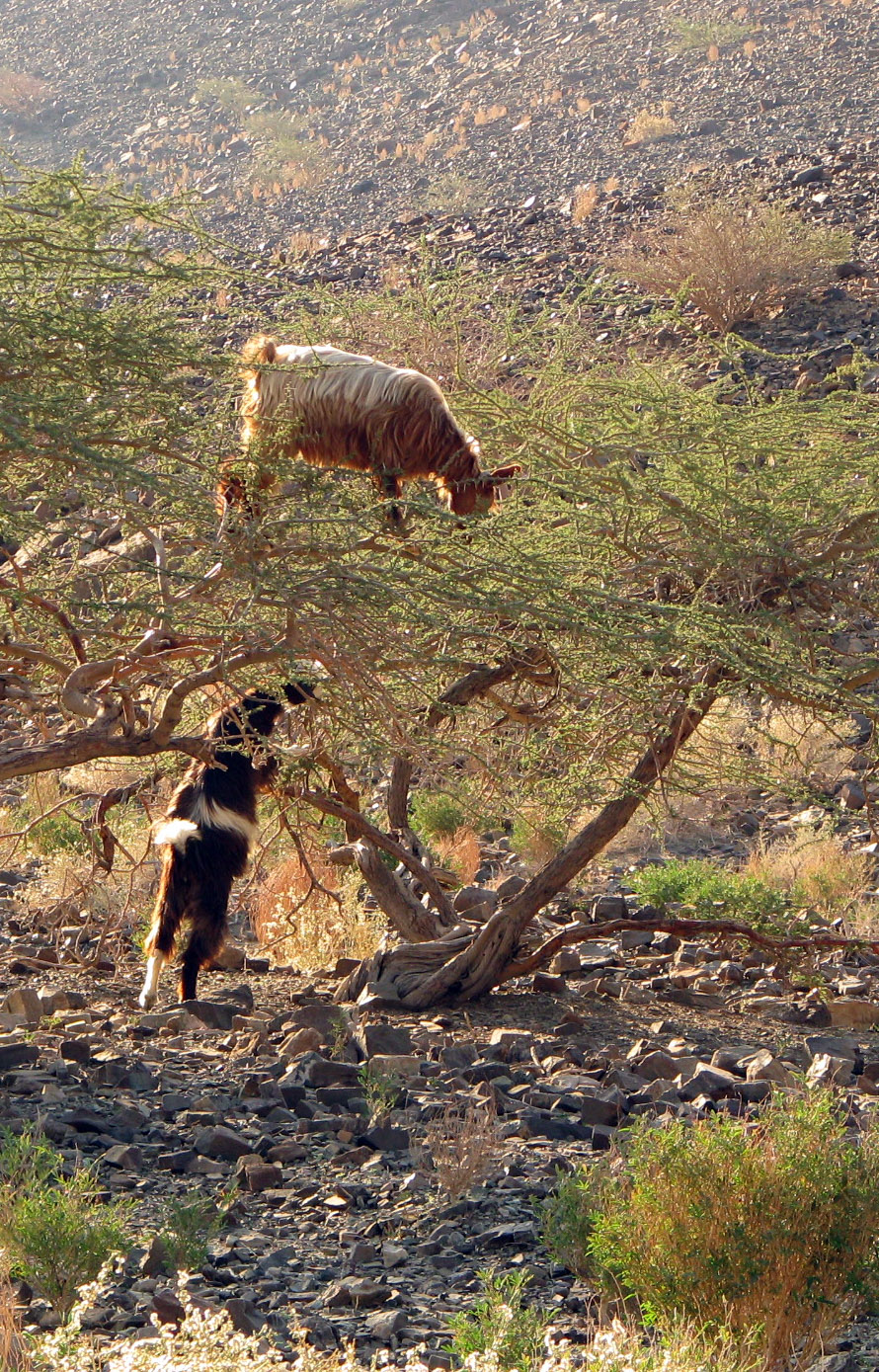Aerial talon-show over Papago Park
Had a nice morning walk in Papago Park (Phoenix AZ) this morning — the spring air was breezy and clear, and the high skies brought out a number of aerial show-offs. The main 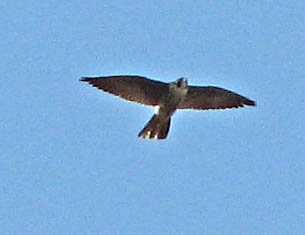 attraction was a Peregrine falcon, spiraling and soaring between the two largest buttes in the Park and the Army National Guard reservation, over McDowell Road.
attraction was a Peregrine falcon, spiraling and soaring between the two largest buttes in the Park and the Army National Guard reservation, over McDowell Road.
<< Peregrine falcon soaring; note typical peregrine dark “hood” and pointed falcon wings (Photo E.Shock)
The falcon’s showy overflights attracted the peevish attention of the local pair of Red tailed hawks, who flew up to try to show it the door. In terms of aerial agility, the big, broad-winged red tails are no match for a nimble sickle-winged falcon, but we did witness some serious stooping on 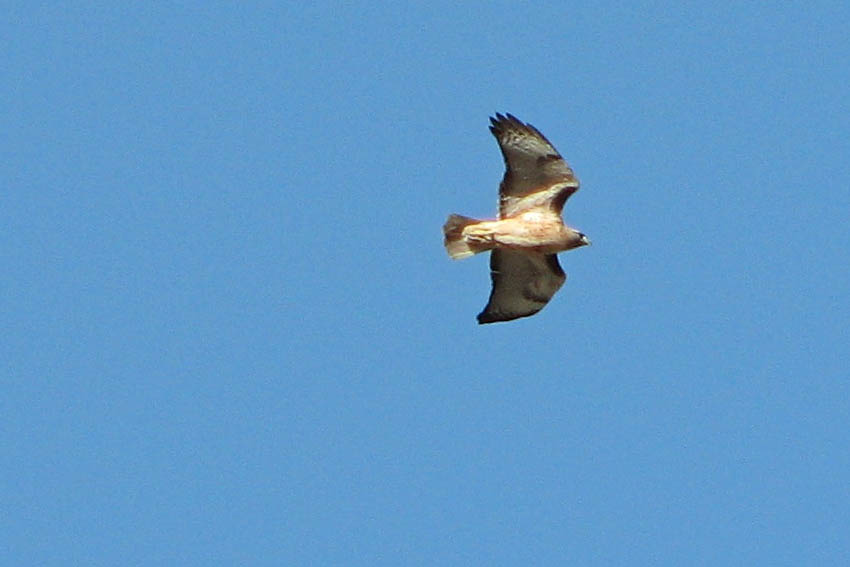 the part of both species, and even one brief roll-over with talon-grappling incident.
the part of both species, and even one brief roll-over with talon-grappling incident.
<< Redtailed hawk, in a power glide. Note black patagium — leading wing edge close to head — one of the best field marks for IDing red-tails aloft (Photo E.Shock)
This action went on among sparse clouds of White-throated swifts — was the probably migrating Peregrine trying to nab a quick swift-to-go before heading north, the raptor equivalent of a drive-thru fast food breakfast burrito?
No wonder the Redtails were upset — a little searching with binox of the inaccessible red rocks on the Military’s property turned up the hawks’ nest, a substantial stick-pile wedged in a ledge on the butte. We’ve suspected they were a nesting pair, but now we know for sure.
A loggerhead shrike was on duty, as well. Spring has been cool, and there are still very few insects around, which 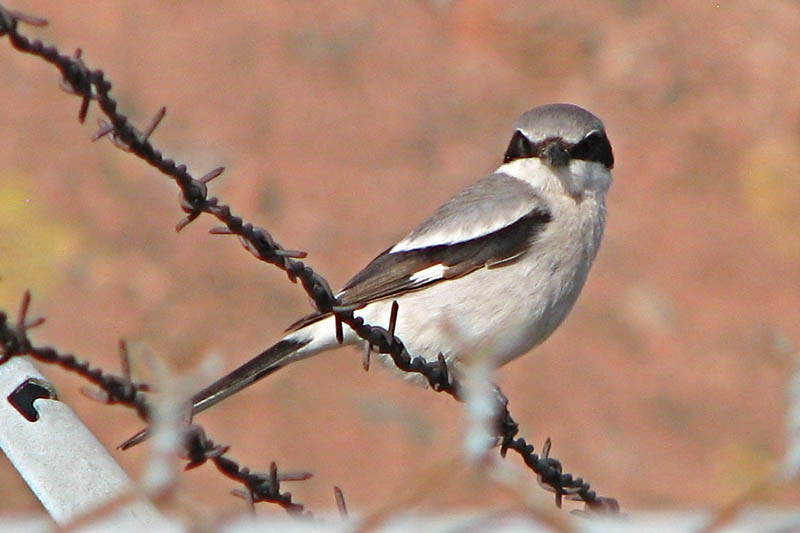 suggests that the Lesser goldfinch and lingering white-crowned sparrows in the desert park might wish to keep sharp.
suggests that the Lesser goldfinch and lingering white-crowned sparrows in the desert park might wish to keep sharp.
<< The last thing the grasshopper saw. Loggerhead shrikes are sometimes called “functional raptors” because although they’re Passerines (perching birds) they prey on insects and small mammals, qualifying them as birds of prey. Dig the tiny white “eyebrows”. (Photo E.Shock)
 The photo of the p-falcon’s a bit grainy due to having to magnify it, but please click on the Red-tail and the Shrike images to enlarge them so you can admire the good feathery detail.
The photo of the p-falcon’s a bit grainy due to having to magnify it, but please click on the Red-tail and the Shrike images to enlarge them so you can admire the good feathery detail.
<< Oh, and here’s King Kong… Their nest is near here, and the Red-tails love to perch on his brow and warm themselves on a sunny morning.
It’s the most bunnerful time of the year
<< Two of these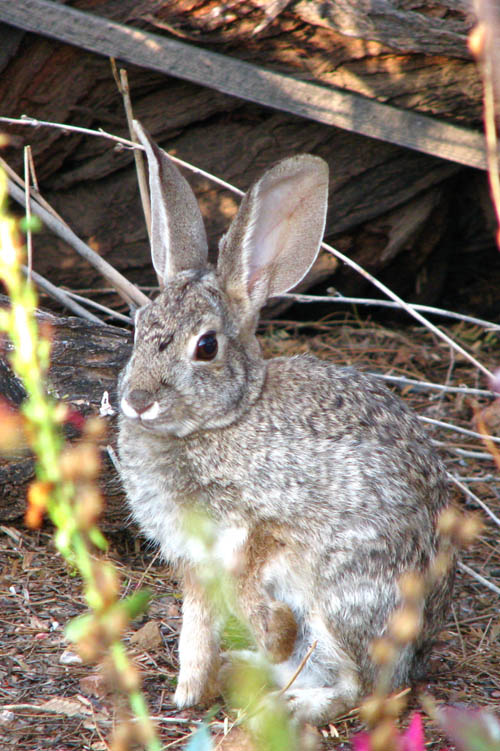 equals these. ↓
equals these. ↓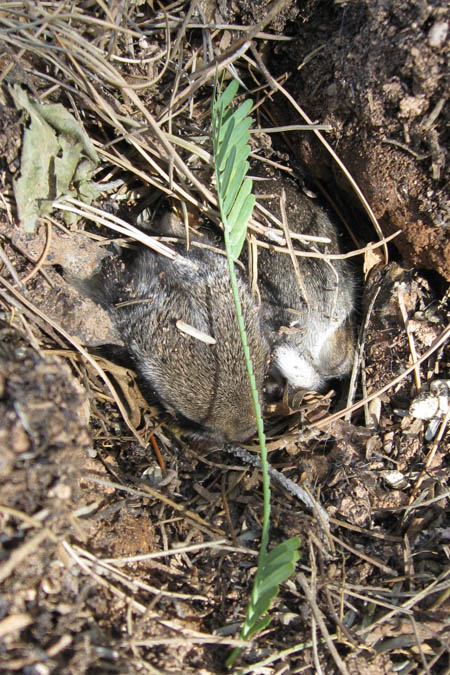
Desert cottontails abound in the yard right now. The desert is green from the late winter rains, so there’s lots to eat. Adult frolicking leads to tiny bunlets. The two in the photo above on the right were stashed by mom in a shallow scrape right out in the open. When we discovered them, while checking on the mantis egg case, they were barely 3 inches long. A day later, they were gone, leaving only the “form” behind in the mesquite leaf litter. Moved by mom, eaten, or hopped off under their own power, we’ll never know.
(All photos E.Shock)
Two more Ganskopf “fetishes”: stone owls or just rocks?
This is the fifth installment of the Ganskopf series. Read the first, second, third and fourth here.
“Professor Harrower wants to speak to me?” I asked, surprised. Miss Laguna nodded, and pushed the phone towards me in the air.
After months of contact by letter — and snail mail at that — to say that I was surprised to be called on the phone, at the Ganskopf Library, by Professor Harrower was putting it mildly (not to mention how much it sounded like an Accusation in Clue). I put the phone to my ear, its tangled coil-cord knocking over a cup of pens on Miss Laguna’s desk. “Yes?” I asked. The professor spoke in a quiet voice, tinted with a soft accent I couldn’t quite place. With no pleasantries except a “good afternoon”, he made his request directly and said goodbye. I handed the phone back to Miss Laguna, who had managed to take the entire length of the call to reorganize the pen cup.
— to say that I was surprised to be called on the phone, at the Ganskopf Library, by Professor Harrower was putting it mildly (not to mention how much it sounded like an Accusation in Clue). I put the phone to my ear, its tangled coil-cord knocking over a cup of pens on Miss Laguna’s desk. “Yes?” I asked. The professor spoke in a quiet voice, tinted with a soft accent I couldn’t quite place. With no pleasantries except a “good afternoon”, he made his request directly and said goodbye. I handed the phone back to Miss Laguna, who had managed to take the entire length of the call to reorganize the pen cup.
“Miss Laguna, do you know Harmon Harrower personally?” I asked. She nodded, and explained he made infrequent trips to the Collection. I asked, “Do you happen to know where he’s from, I mean originally?”
“Texas,” she replied, “born and raised. I believe his PhD is from Rice.”
“No kidding? He’s an Owl?” This seemed too odd to be coincidence. “Well, Professor Harrower has another two ‘fetishes’ he wants me to render before I leave. How late is the Library open?”
“Until 9pm. There’s plenty of time if you’d like me to pull them for you,” she said.
“Then, would you mind?” I gave her the scrap of paper with the accession numbers, and moved back to a table to unpack my kit. She returned promptly with two tiny figures, this time with hands once again carefully encased by purple latex gloves.
Here is the finished aquarelle pencil and ink illustration: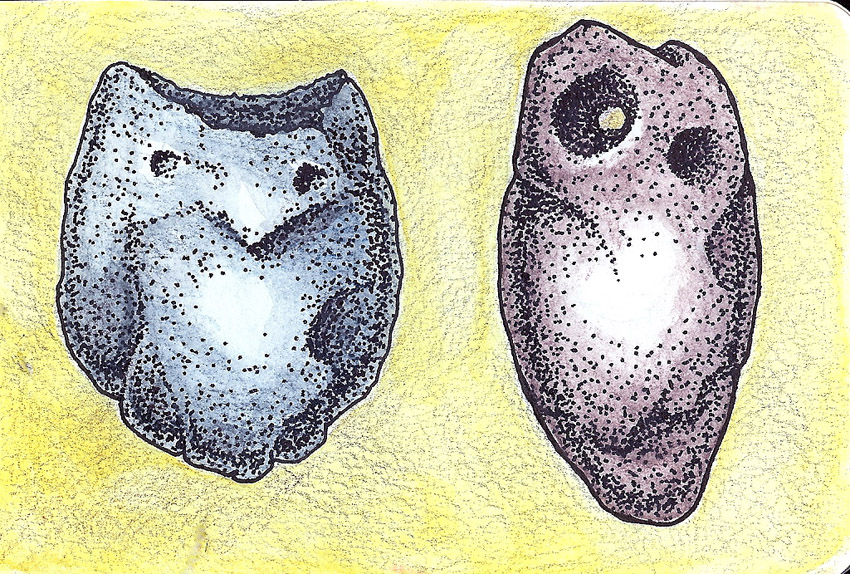
Again, I omit detailed notes on them here, except to say that the items were stone owls, no more than two inches tall, perhaps made owl-like by human hands, or perhaps just fortuitously owly cobbles. I leaned as close as I could to the velvet pillow, and peered at the objects through my magnifying glasses. There was a shininess or patina on them — especially around the bellies and beaks — that could have been made by frequent handling or rubbing. I leaned back. I suppose if I ever found an owl-shaped stone, I’d pick it up, too: just because they might not be fabricated didn’t mean they weren’t artifacts. My gut feeling was that human-shaped or not, they could be very, very ancient; prehistoric ancient, even.
For these two “fetishes”, I chose a stippling technique to render their patinated, weathered cortex, remembering how effective that technique was for drawing Acheulian stone handaxes and other cobble-based implements during a summer internship at the Lancaster Anthropology Museum.
As I worked on the preliminary sketches, various facts kept the analytical part of my brain occupied: Professor Harrower wanted the illustrations for an article. But he had been working on this article for an awfully long time — wouldn’t he want to catch the wave of public interest in these “mystery relics”? And also, why were his payments and re-imbursements to me always in the form of money orders, rather than checks from his University? On further reflection, I decided this might be because he was moonlighting — writing a piece for a popular publication, not a technical journal. This could explain why exact measurements weren’t critical; also, why he had asked for colorful renderings. (The objects themselves tended to be mute in color, so I’d solved this with bright backgrounds, which had seemed to satisfy him.) But mostly what I reflected on was this: the absolute certainty that, based on the speaker’s accent, my phone conversation today was not with a Texan.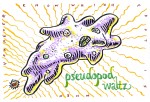
With provocative thoughts like these, time passed quickly, but it was a little after nine when I finished up. Miss Laguna had already put on her coat. I asked if she would let me buy her a quick dinner by way of thanks for holding the Library open a bit late (I could afford it, I was working with a per diem). She smiled, but said she had to get to her night job, so I just grabbed a slice of pizza on the way back to the hotel.
In general, the food here isn’t as good as in New Elgin, and the pizza was heavy and soft with flabby cheese. As I walked along the street struggling one-handed to keep it from dripping oil on my sweater, I wondered: what do you suppose a special collections librarian does for a night job?
To be continued.
Wild mantid-loaf: imagine another surprise!
A praying mantis egg-case is not something you can easily find if you’re looking for one. So, imagine our surprise — again! — when E looked up at a random, leafy, and low branch of the big backyard mesquite, and said, “Hey,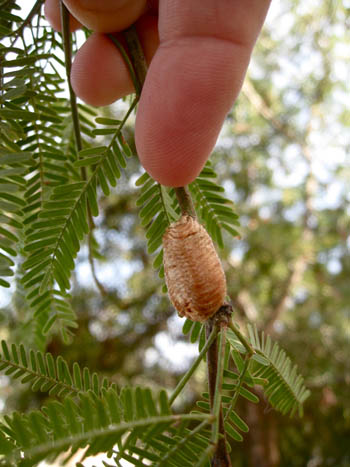 look!” There was a tiny brown-loaf-looking mantid egg case, stuck to a thin twig towards the whippy tip of a branch.
look!” There was a tiny brown-loaf-looking mantid egg case, stuck to a thin twig towards the whippy tip of a branch.
This was our second mantis-related sighting of the week — the other is described here, in the latest post on this blog.
So, we’ll be keeping an eye on this one, to see if it hatches, now that warmer weather is here. And, who knows how many more are out there? With luck, the yard will be mantis-rich before long.
Praying mantis egg-case on mesquite twig, finger for scale (Photo A.Shock) >>
And stay tuned to read about what I encountered under the mesquite just now, while checking on the mantis-egg case…
Lil mantids, or: imagine our surprise
We grow succulents at our house in containers, and some of them can’t take the heat of the low desert summers, while others can’t take the hardest frosts of winter. This results in a constant migration of plants inward and outward between the house and yard, depending on the season. The indoor space the plants inhabit is a set of wall-shelves 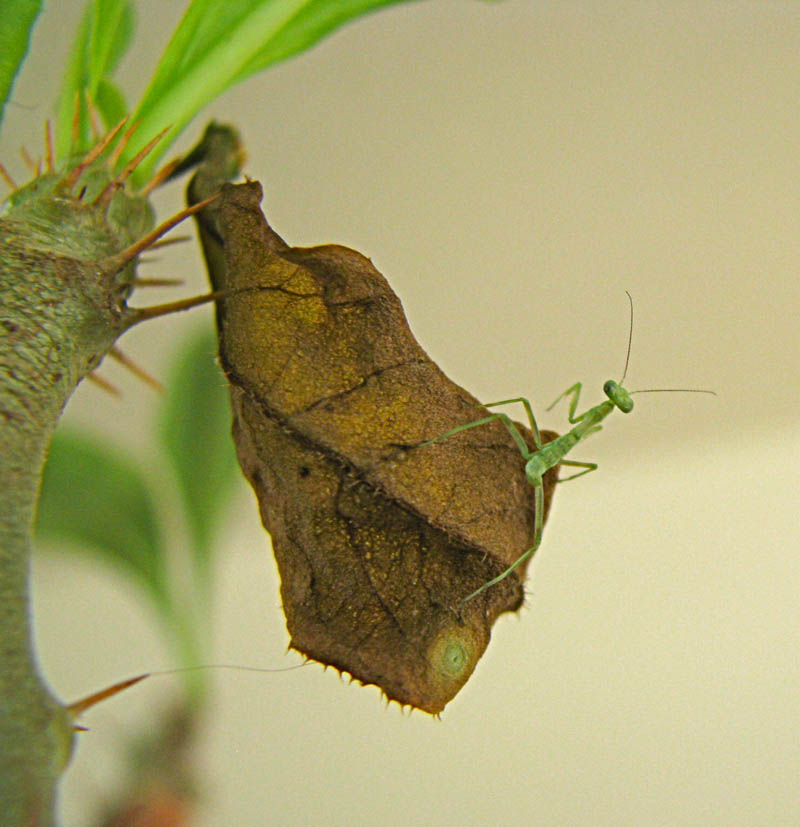 perched in a loft area above the bed. Every once in a while the cats get up there – in the avatar of furry negative forces of destruction and sudden catastrophe – and implement their conviction that one or the other potted plant would be better on the carpet, which results in a loud thump, crushed foliage, and a shower of dirt and gravel onto us in the middle of the night, causing much heart-pounding and swearing.
perched in a loft area above the bed. Every once in a while the cats get up there – in the avatar of furry negative forces of destruction and sudden catastrophe – and implement their conviction that one or the other potted plant would be better on the carpet, which results in a loud thump, crushed foliage, and a shower of dirt and gravel onto us in the middle of the night, causing much heart-pounding and swearing.
The other result of having the indoor-outdoor shift in place is that things get imported into the bedroom that really would be better off outside. Last fall, unbeknownst to us, one of the plants that came in for the cold season was an Adenium where a Praying mantis had secreted her breadloaf-brown egg case. 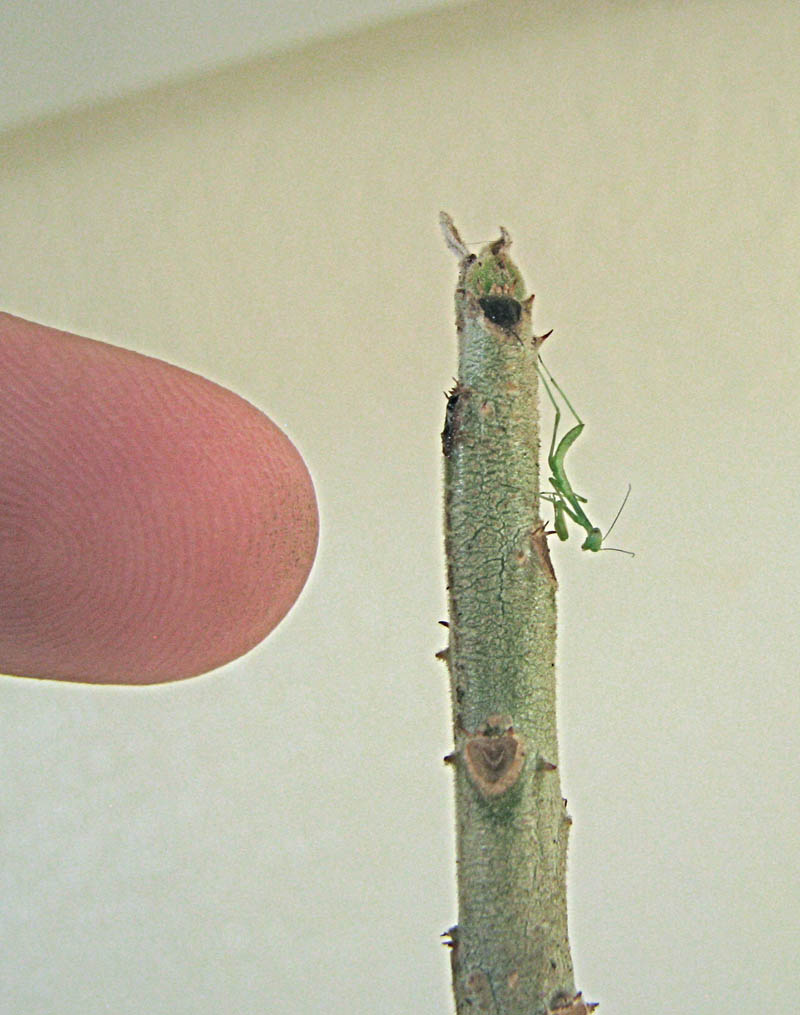 The first we knew about it was when E went up the spiral staircase to water plants, and found, pinnacled on the tip of a succulent, the tiniest possible baby green mantis – looking just like a big one, but not as big as a human fingertip. A quick search around yielded a dozen more, freshly hatched, as well as the egg-case itself on a nearby plant.
The first we knew about it was when E went up the spiral staircase to water plants, and found, pinnacled on the tip of a succulent, the tiniest possible baby green mantis – looking just like a big one, but not as big as a human fingertip. A quick search around yielded a dozen more, freshly hatched, as well as the egg-case itself on a nearby plant.
We instantly whisked the nest-plant outside, before the fur-bearers discovered the movable feast of lively greenlings, and where they could disseminate into the garden and find plenty of food to eat, unlike the largely tiny-prey free desert of the bedroom. We’ve had young mantises around before and they are very voracious younglings, eating anything that moves which they are strong enough to grasp and render immobile. This is the other function of allowing them to wander off, each in a different direction — they will eat each other, if hungry enough.
By next morning, all but one of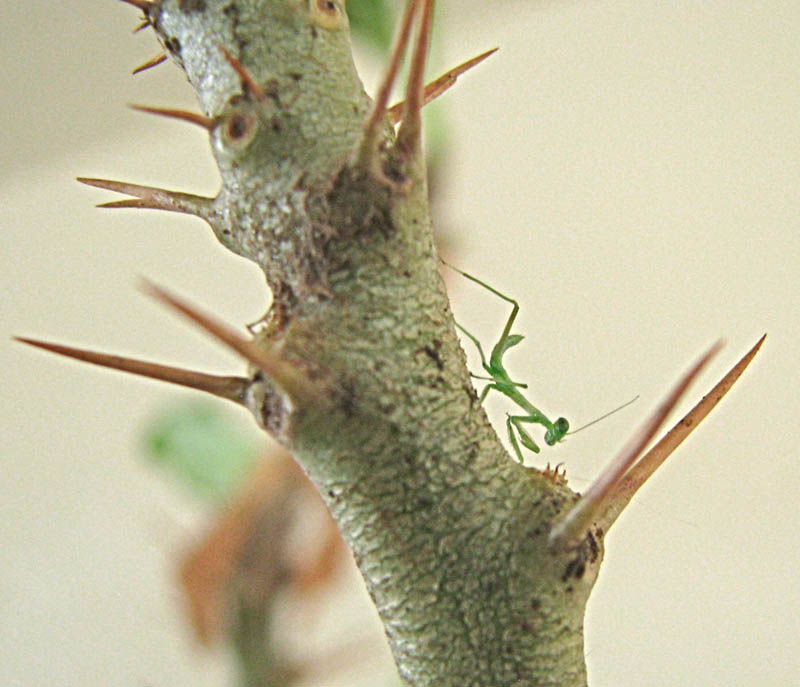 them had made its way away from the eggcase Adenium, except for one guy who figured he was okay where he was. With luck they will mature into one of the mantids native to the Sonoran desert. Or, they may grow into an imported mantid from the Mediterranean or China that people release to control garden pests. Of course, many may be eaten by birds or raccoons, but even that way, they’re in the natural system, and out of the bedroom. Bonne chance, tiny predators!
them had made its way away from the eggcase Adenium, except for one guy who figured he was okay where he was. With luck they will mature into one of the mantids native to the Sonoran desert. Or, they may grow into an imported mantid from the Mediterranean or China that people release to control garden pests. Of course, many may be eaten by birds or raccoons, but even that way, they’re in the natural system, and out of the bedroom. Bonne chance, tiny predators!
(all photos by E. Shock)
Rio Salado in early spring
Today I actually got outdoors to breathe air, soak up sunbeams, and take a look at what’s up, and what’s in the air. It’d been awhile, and I thought I’d celebrate by passing along some of what’s 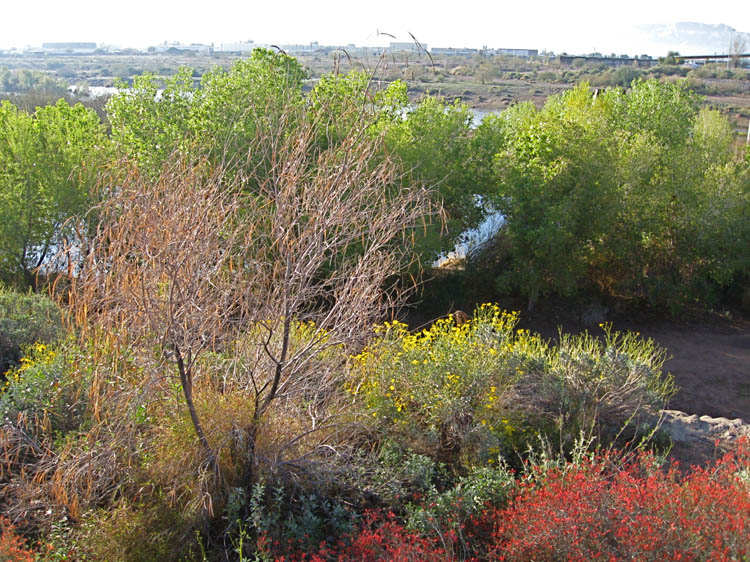 happening along the Salt River, smack in the middle of the City of Phoenix, AZ.
happening along the Salt River, smack in the middle of the City of Phoenix, AZ.
<< green Goodding’s willows, brittle bush, Desert willow, and chuparosa at Rio Salado; photo A.Shock
The Rio Salado Habitat Preservation Area, as it’s officially designated (here is the website), is an ex-horrific-riverside urban dump that’s been cleaned up and improved in order to attract and showcase permanent and migrating wildlife, including birds, mammals, and insects.
Along the Salt River just south of downtown Phoenix, the RSHPA is less than 10 miles downstream from the riparian area at Tempe Town Lake (see here), and has a variety of habitats, from mesquite bosque to shady bands of Goodding’s willows (the bright green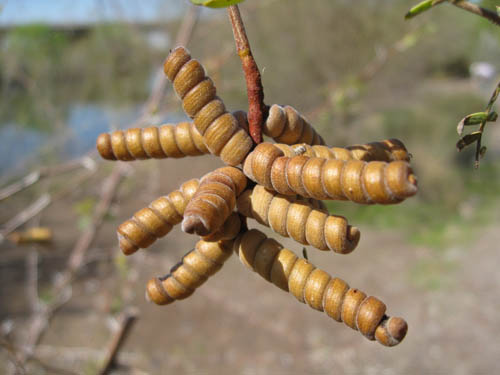 foliage in the photo above.) Each time I visit, the vegetation is better established, both naturally (Goodding’s willows are said to be able to grow something like six feet per year), and with the help of human hands — many native desert and riparian plants have been planted along the bike path and walking trails that weave along the river, on both sides. Right now, the Goodding’s willows are in bloom. The screwbean mesquites (right) are still bare, making their tightly-twisted seed pods stand out against the blue sky, clustered like little brown bouquets of rattlesnake rattles.
foliage in the photo above.) Each time I visit, the vegetation is better established, both naturally (Goodding’s willows are said to be able to grow something like six feet per year), and with the help of human hands — many native desert and riparian plants have been planted along the bike path and walking trails that weave along the river, on both sides. Right now, the Goodding’s willows are in bloom. The screwbean mesquites (right) are still bare, making their tightly-twisted seed pods stand out against the blue sky, clustered like little brown bouquets of rattlesnake rattles.
The river is high today after all of the rain in both the metro basin and in the high country north east of Phoenix, but it’s obviously been higher recently: big piles of flood debris are left on both sides of the trail. 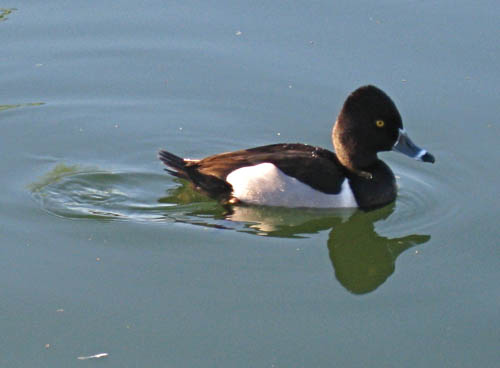 Cormorants (Double-crested and Neotropical), American coots, and Killdeer are common along the river, and the ponds and oxbows host a variety of waterfowl, like this handsome Ringnecked drake (left), Cinnamon teal, and Common moorhens. But we were especially on the lookout for dinky dudes — in this case, an out-of-range straggler, a Black and white warbler that’s been hanging out at the Rio for at least a week. It proved too dinky to photo, but we did get crippling looks at the tiny tourist, wrestling an enormous caterpillar into its gullet. It was keeping company with a Brown creeper, numerous Orange-crowned and Yellow-rumped warblers, Ruby crowned kinglets, a Blue-gray gnatcatcher, and other dinky dudes. A casual couple of hours of birding yielded a list of more than 35 species of birds, including a House wren.
Cormorants (Double-crested and Neotropical), American coots, and Killdeer are common along the river, and the ponds and oxbows host a variety of waterfowl, like this handsome Ringnecked drake (left), Cinnamon teal, and Common moorhens. But we were especially on the lookout for dinky dudes — in this case, an out-of-range straggler, a Black and white warbler that’s been hanging out at the Rio for at least a week. It proved too dinky to photo, but we did get crippling looks at the tiny tourist, wrestling an enormous caterpillar into its gullet. It was keeping company with a Brown creeper, numerous Orange-crowned and Yellow-rumped warblers, Ruby crowned kinglets, a Blue-gray gnatcatcher, and other dinky dudes. A casual couple of hours of birding yielded a list of more than 35 species of birds, including a House wren.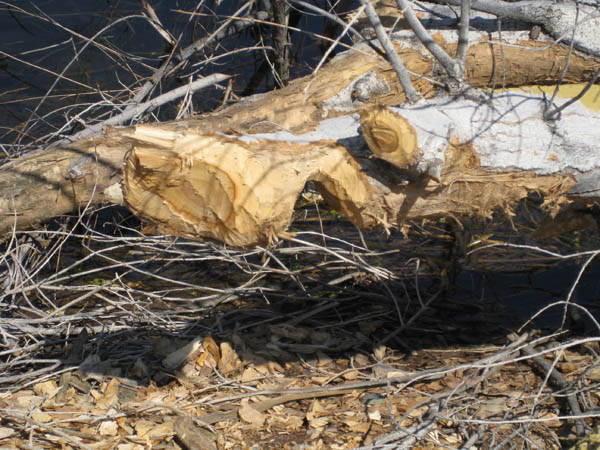
But for me, the surprise of the day was provided by our furry mammalian neighbors: there’s a beaver working the Rio! We didn’t see the critter itself, but check out the evidence of Beavers At Work. right >>
I love the industrious pile of wood chips under the chewed ends of this downed tree.
Anyone birding in the Phoenix area during autumn through spring seasons might wish to 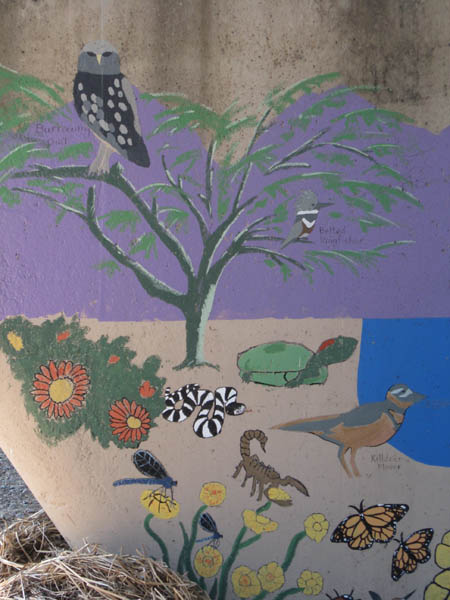 check out RSHPA .
check out RSHPA .
Remember — it’s an urban birding gem, so you might wish to bring a friend, and don’t leave anything valuable in your car.
Don’t be discouraged by the urban nature of this area, it’s got its advantages, too, like some really nice public art along the paths, and under the bridges on otherwise blank concrete supports.
>> Local wildlife painted under Central Ave bridge, RSHPA (all photos A.Shock)

